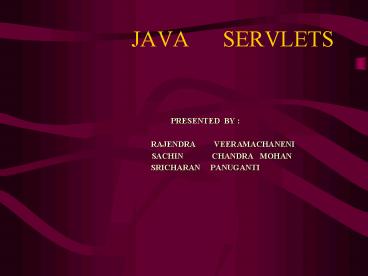JAVA SERVLETS PowerPoint PPT Presentation
1 / 18
Title: JAVA SERVLETS
1
JAVA SERVLETS
- PRESENTED BY
- RAJENDRA VEERAMACHANENI
- SACHIN CHANDRA
MOHAN - SRICHARAN PANUGANTI
2
What is a servlet ?
- Servlet is a server side applet.
- Servlets are modules of Java code that run in a
server application. - Servlet is a small, pluggable extension to a
server that enhances the servers functionality.
3
Advantages of servlets
- Servlets are cross platform.
- Servlets are fast.
- - Servlets uses a single process
multi-threaded model. - Servlets are elegant.
- - Easy to maintain and understand.
- Servlets are secure.
- -Javas strong typing helps to ensure
security.
4
- Servlets can handle run time errors.
- Simple and extensible API.
- Portability across servers.
- - Servlet API is available on web servers like
Apache, Microsoft IIS, Netscape etc. - Servlets can handle multiple requests.
- Servlets can forward requests.
5
Architecture of the Servlet Package
servlets
Generic servlets
Http servlet
My servlet
6
- A generic servlet should override its service ()
method. - The service ( ) method accepts two parameters.
- - A request object and a response object.
- An HTTP servlet overrides doGet ( ) method to
handle GET requests and doPost ( ) method to
handle post requests.
7
The servlet lifecycle
8
A Simple Servlet public class
SimpleServlet extends HttpServlet
public void doGet (HttpServletRequest request,
HttpServletResponse response)
throws ServletException, IOException
PrintWriter out
String title "Simple Servlet Output"
response.setContentType("text/html")
out response.getWriter()
out.println("ltHTMLgtltHEADgtltTITLEgt")
out.println(title)
out.println("lt/TITLEgtlt/HEADgtltBODYgt")
out.println("ltH1gt" title "lt/H1gt")
out.println("ltPgtThis is output
from SimpleServlet.")
out.println("lt/BODYgtlt/HTMLgt")
out.close()
9
SERVER - SIDE INCLUDES
- Servlets can be embedded inside HTML pages with
server-side include (SSI) functionality. - A page can processed to include output from
servlets at certain points. - Java Web server parses pages with .shtml
extension.
10
Server - side Include
Web Server
.shtml file
ltHTMLgt ltHEADgt lt/BODYgt ltSERVLET CODESERVLET1gt lt/SE
RVLETgt lt/BODYgt lt/HTMLgt
Request
Servlet1
Response
11
- ltSERVLET CODEServletname CODEBASEhttp//serv
erport/dir - intiParam1initValue1 initParam2initValue2gt
- ltPARAM NAMEparam1 VALUEvalue1gt
- ltPARAM NAMEparam2 VALUEvalue2gt
- lt/SERVLETgt
- CODE specifies the class name of the servlet
to invoke. - CODEBASE specifies the remote location from
which the servlet should be loaded.Parameters
can be passed to the servlet using the ltPARAMgt
tag. - Server detects the ltSERVLETgt tag and
substitutes the servlet output in its place.
12
SERVLET CHAINING
- Requests can be handled by a sequence of
servlets. - Request from the browser is sent to first servlet
in the chain. - The output of each servlet is piped to the next
servlet. - The output of the last servlet is returned to the
browser.
13
Servlet Chaining
Request
Servlet 1
Servlet 2
Response
Servlet 3
14
Methods to trigger a chain of servlets
- Specify to the server to handle URLs by an
explicitly specified chain. - Specify the server to send all the output of a
particular content type through a specified
servlet. - Filtering- conversion of one type of content into
another by a servlet. - Examples Converting text from a page to a
language which can be read by the client,
converting non standard images to standard ones
using filtering.
15
SECURITY
- Three important issues in web security
- Authentication To verify the identities of
parties involved - Confidentiality Ensure that the only the parties
involved understand the communication. - Integrity Verify that content of the
communication is not altered during transmission.
16
HTTP Authentication
- HTTP protocol provides built-in authentication
support - basic authentication - Based on simple user/password model
- When user requests for a resource, server
responds with request for username and password - If it matches with information in the servers
database, access is granted - Drawbacks
- No confidentiality or integrity
- Most basic authentication
17
Custom Authorization
- Servlet can be implemented to know about users
from specially formatted file or a related
database. - Servlet uses status code and HTTP headers to
manage security policy. - Servlet receives encoded authorization in the
Authorization header. - If a servlet denies credentials, it does so by
sending the SC_AUTHORIZATION status code and a
WWW-Authenticate header that describes required
credentials.
18
Form Based Custom Authorization
- Servlets can perform custom authorization by
using HTML forms and session tracking. - Gives users a well designed, descriptive and
friendly login page. - When a request for a resource is made, the
servlet checks if the user is logged in by
checking the client session object. - If the object exists, it allows the user to
access the resource. - If not, it saves the request URL for later use.
19
Security features of Servlets
- Since Servlets are developed in java, they follow
rules of a security manager which greatly limits
the servers exposure to risk. - Servlets use digital signatures enabling remotely
loaded servlets access to resources after
authentication.

